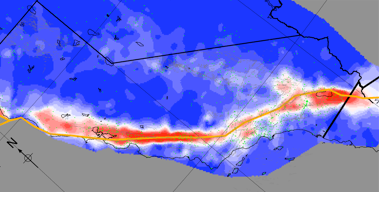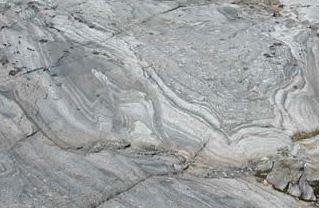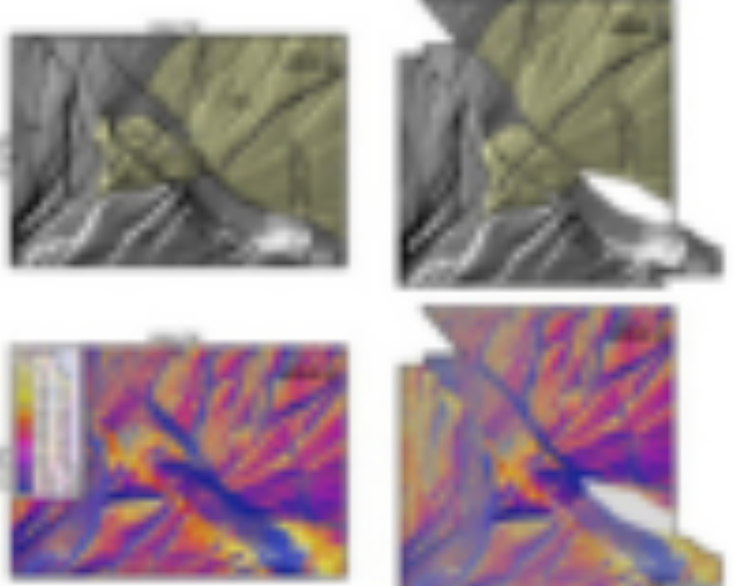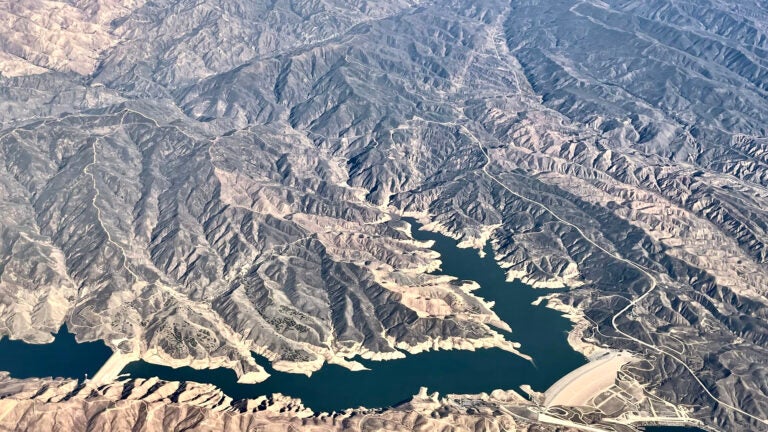Focus on Tectonics
-

The Crustal and Lithospheric Dynamics Group at USC are involved in a collaborative program of research into the mechanics of plate-boundary deformation. This includes studies of:
- The way strain is distributed within the San Andreas transform zone of California
- The role of the upper mantle in driving back-arc extension in the western Mediterranean
- The strength of the crust in extending regions
We apply a range of research methods, including geodesy, observational seismology, structural analysis, petrology, geochronology, and paleomagnetism, with the aim of testing mechanical models, and defining more precisely the distribution and rates of deformation in deforming regions.
PICASSO
Program to Investigate Convective Alboran Sea System Overturn:
A multi-disciplinary effort to understand the geodynamics of the westernmost margin of the Mediterranean based on geological and seismological imaging, petrology, and fluid dynamical modeling.Image: Electron backscatter diffraction image of deformed quartzite from southern Spain. The colors indicate the crystallographic orientation of the grains. Study of dynamically recrystallized grainsize in rocks like these allow measurement of the flow stress during deformation.
Deep Structure of Lithospheric Faults
Implications of the rheology of ductile shear zones for the width of plate boundary fault zones below the brittle-ductile transition.Transforms
Aims to investigate the tectonics of the San Andreas Transform system, primarily through the use of the geodetically-defined velocity field in California. It has three main themes: Geodetic and seismotectonic constraints on the active tectonics of California, Analysis of the slip-rate distribution on SAF-related faults in California, and the Bookshelf slip on rotating panels of sinistral faults within the San Andreas Transform system.Exhumation of High-Pressure Metamorphic Rocks in Accretionary Orogens
Aims to investigate some of the outstanding problems in the Franciscan Complex: California’s Mesozoic – Tertiary accretionary complex by a detailed structural analysis of the Paskenta – Covelo transect in the northern Coast Ranges. Some of these issues include: Origin of mud-matrix melanges, contractional deformation, exhumation of high-P metamorphic rocks, and the nature of the Coast Range Fault.Aims to develop naturally constrained profiles of the strength of the lower continental crust near the brittle-ductile transition using paleopiezometry, geothermobarometry, thermochronology, and numerical modeling to understand the stress-temperature-depth evolution of exhumed mid-crustal rocks.
Crustal Strength
Aims to develop naturally constrained profiles of the strength of the lower continental crust near the brittle-ductile transition using paleopiezometry, geothermobarometry, thermochronology, and numerical modeling to understand the stress-temperature-depth evolution of exhumed mid-crustal rocks. -

Magmatic systems research at USC focuses on understanding how melts form, how they are transported through and locally stored within the lithosphere and sometimes erupted on Earth’s surface, and how these processes affect the behavior of the lithosphere.
Earth Sciences faculty at USC are particularly interested in the growth and evolution of continental arcs, the most rheologically complex orogenic zones on earth, where rock viscosities vary over 16 orders of magnitude, temperatures over 1200 oC, and compositions over a wide range, making these settings a wonderful natural laboratory for research and teaching.
USC’s Magmatic Systems research involves faculty from Tectonics and Geophysics and collaborations with geochemists and geochronologists at several institutions across the country. Our field areas extend throughout the western margin of North America, from Baja to Alaska. USC faculty and grad students have worked in the Lachlan Fold Belt, Australia, New Zealand, Argentina, and Ireland and are now venturing into the Gobi-Altai in Mongolia, and a number of areas in China and Europe.
Projects include:
-
- Detailed multi-disciplinary studies of batholiths – Mt. Stuart batholith, Cascades, Washington, and the Tuolumne Batholith, Sierra Nevada, California
Examination of vertical changes in arc crustal sections – Cascades core, Washington, Transverse ranges, California, and recently, the Gobi-Altai, Mongolia
Studies of the effects of ridge subduction on arc magmatism – Alaska
Magmatism during terrane accretion, then transpression, then transtension – the Cascades, Washington and the Sierra Nevada, California
Research on the effects of transitional basement, arc collision, and orogeny – Baja California, Mexico
Thermobarometry of pluton emplacement and use of pluton minerals to recover pressure-temperature-time information
Proterozoic crustal evolution, including the world-wide Mesoproterozoic emplacement of anothorsite, charnockite, and potassic granite
-
-

The Active Tectonics program at the Department of Earth Sciences at USC focuses on the behavior of active and ancient faults and their associated folds, with the ultimate goal of understanding the mechanics of plate-boundary deformation. We work mainly at the critically important time scale of one to a few dozen earthquakes, with the goal of understanding the detailed interactions amongst the various tectonic elements that comprise plate boundaries.
We operate at the interface between structural geology, seismology, tectonic geomorphology, geodynamics, and seismic hazard assessment, and take full advantage of emerging technologies, such as LiDAR airborne laser swath mapping and cosmogenic radionuclide dating.
Recent research projects include:
- Analyses of slip rates and paleo-earthquake ages and displacements on a number of major continental faults designed to elucidate the pace and constancy (or lack thereof) of relative plate motions at the earthquake time scale
- Documentation of exhumed faults in the pursuit of constraints on the dynamic behavior and structural evolution of major faults,
- Analysis of the evolution and hazard associated with blind thrust faults
- Study of potential long-distance and long-term fault interactions, and possible triggering mechanisms of earthquake clusters, on both single faults and regional fault networks, with a focus on the relationship between upper crustal faulting and fault loading associated with the interseismic behavior of the lower crust.
The multi-disciplinary nature of these studies requires that we utilize a wide variety of research techniques, including paleoseismologic trenching, high-resolution seismic reflection imaging, analysis of landforms associated with active faults and folds, and both field and laboratory structural analysis of fault-zone rocks.

Exploration
Aerial view of Castaic Lake
(Photo courtesy of Montserrat De Allende Silva)
Related Courses
Please take a look at the recommended courses in Tectonics
